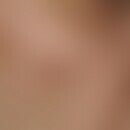Synonym(s)
DefinitionThis section has been translated automatically.
Toxic dermatitis is caused by direct or indirect (aerogenously transmitted) contact or with nettle-hair-bearing lepidopterans(butterfly caterpillars). The following butterfly caterpillars play a role in Europe:
- Golden oyster caterpillar
- caterpillars of processionary moths (oak processionary moth, pine processionary moth, pine processionary moth)
- Bear moth and spotted moth.
Dermatitides caused by butterfly caterpillars have played an increasing role in recent years (Utikal J et al. 2009)
Occurrence/EpidemiologyThis section has been translated automatically.
Only occurs in the warm seasons, especially from May to August. The caterpillars have fine stinging hairs, which they shed. These spread aerogenously and can bore into the skin of people who are close to the nests of the butterfly caterpillars (exposed parts) and cause massive itching of the skin.
You might also be interested in
EtiopathogenesisThis section has been translated automatically.
Direct or (mostly) indirect (aerogenic) contact with the caterpillars' nettle hairs and the protein thaumetopoein (Rodriguez-Mahillo A et al. 2012) contained in them, which acts as a histamine liberator, or has a histamine-like effect itself.
ClinicThis section has been translated automatically.
Strongly itchy erythema and urticarial papules or vesicles, often linear, arranged according to the caterpillar's crawling track. When the caterpillar hairs are distributed by scratching and wiping, caterpillar dermatitis also develops in other places.
It is also possible that the caterpillar poisonous hairs are transmitted through the air, so that a so-called " Airborne Contact Dermatitis" develops. At the same time, respiratory problems and conjunctivitis can also occur.
In rare cases an anaphylactic shock may occur.
HistologyThis section has been translated automatically.
DiagnosisThis section has been translated automatically.
Anamnesis with the connection: stay outdoors/occurrence of dermatitis in the area of exposed skin; detection of stinging hairs by means of a transparent adhesive strip which can be stuck on the skin and examined microscopically.
Differential diagnosisThis section has been translated automatically.
TherapyThis section has been translated automatically.
For severe itching Lotio alba, if necessary with addition of polidocanol 2-5% R200. Alternatively cooling menthol solution or in case of strong local inflammation glucocorticoid-containing external preparations such as 0.1% triamcinolone cream R259 or 0.1% mometasone (e.g. Ecural fat cream). S.a. toxic contact eczema.
General therapyThis section has been translated automatically.
After contact we recommend:
- Immediate change of clothes and the attempt to remove existing stinging hairs from the skin with an adhesive tape.
- Shower or bath the body
- Hair Wash
- If eyes are involved, rinse with water.
Progression/forecastThis section has been translated automatically.
Note(s)This section has been translated automatically.
Practical tipsThis section has been translated automatically.
From the point of view of health protection, control is necessary if infested trees are located near kindergartens, schools or recreational areas, with the main risk period being the holiday season (mid-June to August). Mechanical suction (suction filter class H, respirators full mask with FFP-2 filter) or the use of insecticides are particularly suitable for control. A broad use of chemical agents is, however, questionable from an environmental point of view, as the agents often have a broad spectrum effect and therefore also kill beneficial organisms.
Case report(s)This section has been translated automatically.
- A 7-year-old girl without dermatological or allergological disease career presented in June with a massive itchy, partly urticarial, partly papulo-vesicular rash. 2 days before she had bathed in a forest pond together with her mother and a friend. The first skin changes had also appeared on her mother and friend a few hours after the bath.
- Findings: On the trunk and on 1 leg, asymmetrically distributed, bright red, partly flat, partly linear urticarial papules and papulo-vesicles. The areas covered by the swimsuit were completely free of skin symptoms. In the mother the changes were only pronounced on the thigh.
- Therapy: Under a 0.5% hydrocortisone cream the lesions healed completely within one week.
LiteratureThis section has been translated automatically.
- Rodriguez-Mahillo AI et al. (2012) Setae from the pine processionary moth (Thaumetopoea pityocampa) contain several relevant
allergens. Contact dermatitis 67:367-374. - Schöllnast R et al. (2004) Edematous papules and papulovesicles in mother and child. Dermatologist 55: 480-481
Utikal J et al (2009) Caterpillar dermatitis. An increasing dermatologic problem in warm regions of Germany. The dermatologist 60: 48-50.
Wang D et al (2019) Itchy rash caused by the oak processionary caterpillar.
Ned Tijdschr Geneeskd 163. pii: D4243.
Incoming links (10)
Butterfly caterpillars; Butterfly dermatitis; Caterpillar conjunctivitis; Caterpillar dermatitis; Contact urticaria; Dermatitis, caterpillar hair; Erucism; Oak; Oak; Papilionitis;Outgoing links (22)
Airborne contact dermatitis; Bubbles; Butterfly caterpillars; Butterfly dermatitis; Cercarial dermatitis; Cimicose; Contact dermatitis toxic; Culicosis; Dermatitis bullosa pratensis; Erythema; ... Show allDisclaimer
Please ask your physician for a reliable diagnosis. This website is only meant as a reference.







